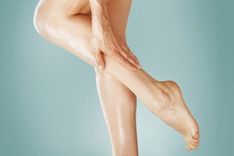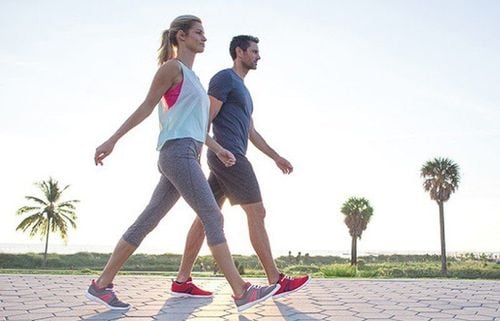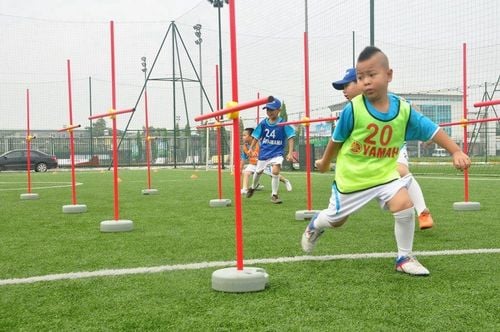Running every day has many health benefits such as losing weight, improving cardiac health, … If you run the right way and keep a good pace, you will not be too tired to rise to the challenge more easily.
1. How to run without being exhausted
To run without being exhausted in the long run, you need to focus on:
1.1 Preparation before running
- Keeping good health: before running, you should be in your best health condition by providing enough calcium and vitamins from food, restricting the food that has little nutrients, and drinking enough water. An appropriate diet not only helps you have good health but also a well-proportioned body.
- Interleaved practice: you should not run the whole week. Instead, you should interleave running with other practices like cycling, swimming, … to increase endurance.
- Warming up: before running, you should warm up. Warming up helps the brain realize what you are going to do and joint lubrication. Before running, you need to stretch out your legs' muscles.
1.2 During running
- Right breathing: take a deep breath through your nose then exhale slowly by mouth. Cooperating running pace with breathing is very good.
- Providing enough water: when you are running, the body will lose water very quickly. Therefore, before running, you should drink a little water. Also, you should carry a bottle of water to provide it during running.
- Build endurance: when you start to run, you should run slowly then elevate the speed gradually until reaching the right pace. Effective speed control helps you run a long distance without getting tired. Whenever you are out of breath, you should reduce the speed for your body to recover. At that time, you can drink water, run at a slow pace then elevate it gradually, not rapidly.
- Running constantly: when you are running, if you are tired, you shouldn’t stop running. Instead, you should decrease the speed and turn running into brisk walking. If you feel pain, that is a sign that you are over-training. You should only focus on improving endurance because it helps you run a long distance without getting tired.

1.3 Motivation for running
- Music: music helps you keep the right pace and provides energy for running. You can choose the song that fits your mood to motivate your running.
- Concentration: you should tell yourself that you can do it to have self-motivation to finish the race
- Find a partner: Running with a partner is a good encouragement to each other to finish the race.
1.4 After running
- Relax the body: after running, you should not rest immediately. Instead, you should walk slowly to relax, and do the stretching for body recovery.
- Enough rest: You do not have to practice 7 days a week. You should spend 1-2 days resting.
- Providing nutrients: after running, you should supply energy for the body for the recovery process. You can use food with rich protein and carbs to provide enough energy.
Other notes for not being tired of running
- Do not start to run at high speed. Running should be started at a slow speed, then elevated gradually.
- Go to the toilet before running
- Try to elevate the speed each week, reduce the time of running at a certain distance, or lengthen the running track.
- Do not put a lot of pressure on running
- Do not run too hard if you are worn out. Listen to your body, and practice appropriately.
- Make a plan for the running track. You should know how long you have run and when you finish.
- Always drink water, and provide electrolytes while running
- Persevere at exercise intensity, running continuously
- Patients with respiratory diseases like asthma should bring drugs and other medical supplies when they are running
- Be careful when running on sunny days, avoid sunstroke

2. Build endurance – help in running without tiredness
Building endurance while running needs time. If you persevere in practice, you can run a longer distance with less tiredness. Some rules need to be remembered when you build endurance for running
2.1 Before running
Understand about RPE
The RPE Scale is a quantitative measure of perceived exertion (body’s feeling). There are different RPE Scales, the easiest one is measured from 1 to 10. In detail, 1 represents the least effort and 10 represents the highest one. Before running, you should have goal setting in your running and use RPE to evaluate your effort during running.
- RPE 2-4: showing slight effort, suitable for warm up and cool down
- RPE 4-5: showing considerate effort, runner practice taking a deep breath but still relaxing
- RPE 5-7: showing from average to high effort. Running is a challenge and you are not sure how long you can keep running.
- RPE 7-9: showing very high effort. You begin to gasp for air
- RPE 10: showing the highest effort
The easy practice running will be at RPE 3-4; the average one is at RPE 4-7 and another speeding exercise will have a higher RPE
Warming up
Warming up is necessary, especially if you are running in cold weather. You should start warm up by running or jogging for about 10-15 minutes in order to pump blood and raise body temperature. If it is possible, you can do some exercise while running or stretch the muscles.
Providing enough energy
Running requires providing enough energy coming from rich glycogen sources. If you participate in a race lasting more than 1 hour, you should have a proper meal before running. When you are trying too hard (like running), the body will automatically turn glycogen into glucose for use. If you have little glycogen in the body, you will be easily exhausted

2.2 During running
Monitor your heart rate
RPE scale helps monitor your heart rate. For example, RPE 2-4 is equivalent to 50-60 % of the maximum heart rate (heartbeat per minute). The maximum heart rate is the upper limit of the heart’s function. The simplest way to estimate the maximum heartbeat is to take 220 and subtract your age.
When you begin to run, you should keep your heart rate under 65% of your maximum one. If you can run with this speed without having arrhythmia, you can increase the speed up to 85%of the maximum heart rate.
Talking while running
Another way to follow the practice’s intensity at an average level is by speaking in full sentences while running. If you cannot speak in full sentences, you should slow down or take a break. You can alternate between running and walking to build endurance, which leads to running without getting tired.
Right running posture
You should run with your upper body straight, not bend over the back. This gesture helps you breathe more effectively since it prevents compression of the diaphragm. Bending over or stooping will decrease the lung’s capacity and raise the respiratory rate while running.
Diaphragmatic breathing
While running, you should breathe from the belly which is opposite to the chest, and try to use the diaphragm to breathe in and out completely. Diaphragmatic breathing helps the lungs have more space to widen more, avoid Exercise-related Transient Abdominal Pain (caused by breathing too fast)
Swing your arms comfortably
While running, you should keep your arm at an angle of 90 degrees with a comfortable posture. When you walk with your right leg, your left arm will swing forward naturally and the same thing happens at the opposite one. This movement helps push the body forward and not lose much strength in your legs.
Comfortable breathing
If you inhale deeply and comfortably, you can feel that your breath will synchronize with your steps. Lots of runners fall into model 2 step 1 breathing, which does not affect much. You just need to find your breath rhythm and relax when you run.
Focus on endurance
You should think about running further or longer rather than running faster. This will help you build endurance, and run longer without getting tired.
If you try all the methods above but find it still difficult to reduce the tiredness while running, you do not need to worry because it is a common condition. If you are tired, reduce the time for running, get some rest then practice later. Also, you need to persevere with your right running plan, you will have a good result soon.
To arrange an appointment, please call HOTLINE or make your reservation directly HERE. You may also download the MyVinmec app to schedule appointments faster and manage your reservations more conveniently.
Reference source: verywellfit.com













